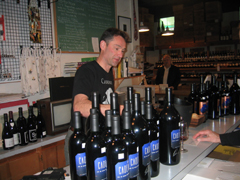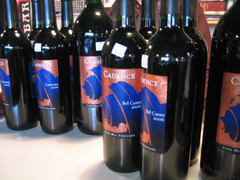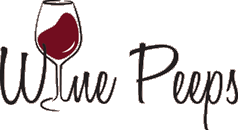Cadence Winery: Striving to hit the right note
By Kori ~ November 14th, 2008.
Last Saturday, Dad (John) and I attended a tasting for Cadence Winery at the McCarthy & Schiering wine shop in Seattle’s Ravenna neighborhood. Winemaker Ben Smith was on hand pouring his wines, talking about them, and sharing pictures of his Cara Mia Vineyard on Red Mountain.
 Ben and his wife Gaye McNutt founded Cadence Winery in 1998. Their winery, open by appointment only, is located in Seattle, Washington. They produce red Bordeaux-style blends from Red Mountain fruit. Ben and Gaye purchased 10.5 acres of prized vineyard land in Red Mountain, generally considered the hottest AVA in Washington State, even before they founded the winery. The first vines were planted in 2004, and their first harvest from Cara Mia Vineyard was in 2006. The recently released 2006 Camerata and 2006 Bel Canto are the debut releases from their vineyard. During this past decade, Cadence has grown to its current yearly production level of 2,400 cases.
Ben and his wife Gaye McNutt founded Cadence Winery in 1998. Their winery, open by appointment only, is located in Seattle, Washington. They produce red Bordeaux-style blends from Red Mountain fruit. Ben and Gaye purchased 10.5 acres of prized vineyard land in Red Mountain, generally considered the hottest AVA in Washington State, even before they founded the winery. The first vines were planted in 2004, and their first harvest from Cara Mia Vineyard was in 2006. The recently released 2006 Camerata and 2006 Bel Canto are the debut releases from their vineyard. During this past decade, Cadence has grown to its current yearly production level of 2,400 cases.
Prior to this tasting, we had not tasted any Cadence wines. Our favorite was the 2006 Camerata (see ratings below). This is the first time that they have produced a predominantly Cabernet Sauvignon wine. All of their wines are blends that bear proprietary names instead of being varietally designated. However, in the case of their 2006 Camerata which is 94% Cabernet Sauvignon, it could be labeled as a Cab if they wanted it to be.
Here is a winery that is trying to do all of the right things. They have gone after the best grapes from some of the best vineyards in the state in the hottest AVA in the state. They have purchased prized vineyard land and have started their own vineyard in that same AVA. And they are producing some good wines. However, I wonder if they might be missing a business opportunity by not producing any varietally designated wines. Let me explain.
As you’ll see from our ratings below, we thought all of their wines were of good quality but not all of them are good buys. Now I completely understand why they are priced the way that they are and I sympathize with the situation faced by many small wineries. They are spending a lot of money on grapes from Red Mountain, have high expenses associated with starting their own vineyard and paying vineyard management fees, and are trying to make ends meet at a modest production level. With that said, when we crunched the numbers, all of their wines received a QPR rating of 1 bang for your buck, except for the Camerata. And the only reason that the Camerata received a QPR of 5 bangs for your buck is because we calculated its QPR based on it being a Cabernet Sauvignon, even though it is not labeled as such. If we had calculated its QPR based on it being a blend, it would only have received a 2 bangs for your buck rating. Wondering why?
 Well, we believe that wines have to be evaluated in relation to their peers and their perception with consumers. While Bordeaux blends from Bordeaux, France, command big bucks, Bordeaux-style blends from the U.S. generally do not. Unlike Bordeaux, France, where all of their wines are blends and those blends are regulated by the government, too often wineries in the U.S. produce blends from their leftovers. They put their best grapes into their Cabernet Sauvignon, their Merlot, etc., and then produce a blend from the grapes that do not quite make the cut. Don’t get me wrong, many of these blends are very good but they are usually priced less than their varietally designated wines. Obviously, Cadence does not do this. They are trying to use the Bordeaux model and make the best wines they can by blending the very best grapes that they can get. But, unfortunately, the average wine consumer does not know this. Therefore, when they walk into a wine shop, they might have a hard time forking over $45 or $55 for a Cadence blend when they can buy any number of other good blends for much less. On the other hand, an excellent Cabernet Sauvignon can average over $100 so an excellent Cab for $55 could be considered a great deal.
Well, we believe that wines have to be evaluated in relation to their peers and their perception with consumers. While Bordeaux blends from Bordeaux, France, command big bucks, Bordeaux-style blends from the U.S. generally do not. Unlike Bordeaux, France, where all of their wines are blends and those blends are regulated by the government, too often wineries in the U.S. produce blends from their leftovers. They put their best grapes into their Cabernet Sauvignon, their Merlot, etc., and then produce a blend from the grapes that do not quite make the cut. Don’t get me wrong, many of these blends are very good but they are usually priced less than their varietally designated wines. Obviously, Cadence does not do this. They are trying to use the Bordeaux model and make the best wines they can by blending the very best grapes that they can get. But, unfortunately, the average wine consumer does not know this. Therefore, when they walk into a wine shop, they might have a hard time forking over $45 or $55 for a Cadence blend when they can buy any number of other good blends for much less. On the other hand, an excellent Cabernet Sauvignon can average over $100 so an excellent Cab for $55 could be considered a great deal.
So Ben and Gaye, if you are reading, keep up the good work. You are doing some great things but you might want to think about how your wines are labeled and positioned in the marketplace to get the most return on your investment.
And bottom line for our readers, go out and pick up a bottle of their 2006 Camerata. It’s definitely worth the money.
In order of our preference in this tasting:
2006 Cadence Camerata, Cara Mia Vineyard (Red Mountain, Washington): 94% Cabernet Sauvignon, 6% Cabernet Franc.
Quality: 4 stars (out of 5)
QPR: 5 bangs for your buck (out of 5)
Where to Buy: Winery, $55; McCarthy & Schiering (Seattle), $55
2006 Cadence Bel Canto, Cara Mia Vineyard (Red Mountain, Washington): 52% Cabernet Franc, 48% Merlot.
Quality: 3.5 stars (out of 5)
QPR: 1 bang for your buck (out of 5)
Where to Buy: Winery, $55; McCarthy & Schiering (Seattle), $55
2006 Cadence Ciel Du Cheval Vineyard (Red Mountain, Washington): 36% Cabernet Sauvignon, 32% Cabernet Franc, 20% Merlot, 12% Petit Verdot.
Quality: 3.5 stars (out of 5)
QPR: 1 bang for your buck (out of 5)
Where to Buy: Winery, $45; McCarthy & Schiering (Seattle), $45
2006 Cadence Tapteil Vineyard (Red Mountain, Washington): 53% Cabernet Sauvignon, 32% Merlot, 15% Cabernet Franc.
Quality: 3 stars (out of 5)
QPR: 1 bang for your buck (out of 5)
Where to Buy: Winery, $45; McCarthy & Schiering (Seattle), $45
Filed under: American Wine, Cabernet Sauvignon, Five-Bangs For Your Buck Wines, Red Wine, Vineyards, Washington State Wine, Wines Over $25

 Wine Peeps is an independent wine blog dedicated to helping you get the most bang for your buck in wine. We do this through blind tastings of wine from around the world and calculations of
Wine Peeps is an independent wine blog dedicated to helping you get the most bang for your buck in wine. We do this through blind tastings of wine from around the world and calculations of 











I think your current categorization of red blends is currently a bit unfair to those wine makes trying to produce a premium blend and certainly misleading to wine consumers. Perhaps some designation like “upscale” red blend vs “the throw all the leftovers together” red blend. This way you would be comparing apples to apples and not lumping everything together. Personally, I prefer the better blends rather than single variety as they generally produce a much more complex wine. I applaud Cadence for their efforts and their wines should be compared to peers (O-S, Note Bene, and DeLille come to mind).
Not to be too disparaging to the “the throw all the leftovers together” red blend makers, as I’ve found some excellent value wines, e.g. Thurston Wolfe Family Red, Tamarack Firehouse Red and Cougar Crest Dedication, although there is no taste consistency from year to year (just interesting wines).
J,
Thanks for your comment. While you make some good points, here are my thoughts on the issues you raised. The average wine consumer does not know which wineries are trying to be “upscale†and which ones are “throwing the leftovers together.†And to try to separate those out into separate categories would be arbitrary and ultimately misleading. When a consumer walks into a wine shop, they are most often confronted with a shelf/aisle of Cabernet Sauvignon, a shelf/aisle of Merlot, a shelf/aisle of Red Blends, etc. Once they decide which shelf/aisle they are interested in, now they must decide which of those wines to buy. Our QPR rating is designed to help them with that decision. By using a calculation that takes into account the wine’s quality rating and price in relation to its peers, the QPR rating helps to determine which wine would deliver the most bang for their buck. It does not give preferential treatment to a wine or winery that is trying to be “upscale†not does it penalize a winery that “throws the leftovers together.†If an “upscale†red blend receives a 3.5 quality rating and costs $55 and a “leftovers†red blend also receives a 3.5 quality rating but costs $20, the QPR rating will clearly be higher for the $20 wine which I believe is a helpful statistic for the consumer. Why pay more for the same level of quality, especially in these tough economic times? Obviously it is up to the consumer to decide whether the price and QPR affect their buying decision.
The reason that we do so many blind tastings is to take the label, price, and philosophy (such as “upscale†versus “leftoversâ€) out of the equation and simply judge a wine based on its merits as compared to its peers (Cabs vs. Cabs, Merlots vs. Merlots, Red Blends vs. Red Blends).
As I said in my post, I think that Cadence is doing some great things, and they are clearly trying to produce premium blends. I just think that they might want to reconsider their market positioning especially since, at least from their first vintage, it appears that Cara Mia Vineyard has excellent potential as a Cabernet Sauvignon producer. And remember, to be labeled a Cab, a wine does not have to be 100% Cab (only 75%) so there is still room for some blending to be done to enhance a wine’s complexity.